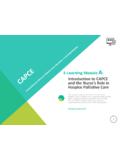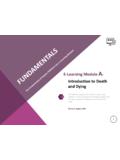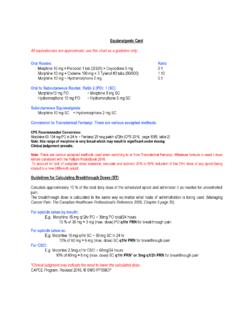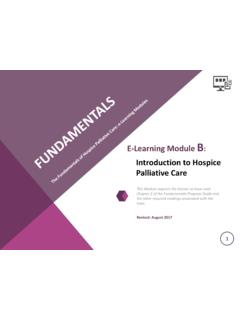Transcription of Program Guide - palliativecareswo.ca
1 The Comprehensive Advanced Palliative Care Education Program GuideA Resource Guide for Health Care ProvidersCAPCE Program GuideiiIntroductioniiiAcknowledgements The Palliative Pain & Symptom Management Consultation Program of Southwestern Ontario, St. Joseph s Health Care London acknowledge the contributions of our colleagues in Hospice Palliative Care who have developed, refined and promoted hospice palliative care education programs throughout Southwestern Ontario. Because of their ongoing commitment, health care providers throughout Southwestern Ontario have a broader knowledge of Hospice Palliative Care and provide better end-of-life care. The Palliative Pain and Symptom Management Consultation Program (PPSMCP) of Southwestern Ontario, St. Joseph s Health Care London provides multi-disciplinary hospice palliative care education and consultation services to health care providers across the continuum of care.
2 This Program is funded by the Ontario Ministry of Health and Long-term Care through the Local Health Integration Networks (LHINs). The primary purpose of the PPSMCP is to build the capacity of service providers to provide quality hospice palliative care. Contents of this publication may be reproduced in whole or in part provided the intended use is for non-commercial purposes and full acknowledgement is given to the South-western Ontario Hospice Palliative Care Education Program and St. Joseph s Health Care London. Please reference as follows:Southwestern Ontario Hospice Palliative Care Education Program . The Comprehensive Advanced Palliative Care Education Program . London: Southwestern Ontario Hospice Palliative Care Education Program , St. Joseph s Health Care London; 2013, second edition 2017.
3 capce Program GuideivHow to Use This Program Guide This Program Guide provides a written resource to the learners who actively participate in the Comprehensive Advanced Palliative Care Education Program . The content in this Program Guide is intended to supplement and compliment the resources outlined in the list of the capce Required and Recommended Learner Resources, including but not limited to the Pallium Palliative Pocketbook, Regis-tered Nurses Association of Ontario Best Practice Guidelines and resources from Cancer Care Ontario. This Program Guide has been developed as part of a blended learning strategy that includes: Independent content review and reflection ( Program Guide and supplementary material) e-Learning Modules Peer-to-Peer Exchange Practical Applications In-person Case-Based Learning Sessions Coaching Revised: March 2018 IntroductionvTable of Contents Introduction i ~ viChapter 1: Introduction to capce 1-1 ~ 1-8 Chapter 2: The Nurse s Role 2-1 ~ 2-10 Chapter 3: Assessment 3-1 ~ 3-10 Chapter 4: Information Sharing 4-1 ~ 4-14 Chapter 5: Decision Making 5-1 ~ 5-8 Chapter 6: Care Planning 6-1 ~ 6-12 Chapter 7: Care Delivery 7-1 ~ 7-6 Chapter 8.
4 Confirmation 8-1 ~ 8-6 Tools T-1 ~ T-38 capce Timeline TL-1 ~ TL-4 Case Based Learning CBL-1 ~ CBL-12 Peer-to-Peer Exchange P2P-1 ~ P2P-4 Coaching Sessions CS-1 ~ CS-30 Practical Application PA-1 ~ PA-36 Required and Recommended Reading List RL-1 ~ RL-6 Worksheets W-1 ~ W-15 capce Program Guidevi1-11 Introduction to CAPCECAPCE Program Guide1-253726481 Chapter 1: Introduction to CAPCE1-3 Program OverviewThe Comprehensive Advanced Palliative Care Education ( capce ) initiative is designed to align with the Model to Guide Hospice Palliative Care1 and supports the outcomes of the Palliative Care stakeholder planning day November 27, 2002. capce is sponsored by the Ministry of Health and Long-Term Care through the Palliative Care Initiatives of CriteriaIn order for the Nurse Practitioner (NP), Registered Nurse (RN) or Registered Practical Nurse (RPN) to be eligible to participate in the capce Program , the following attributes/experience will be considered.
5 A minimum of 1 year experience, (or equivalent as determined by the capce coordination office), caring for people with a progressive, life-limiting illness Ability and interest to function as a leader and mentor, providing primary level support and enhanced-level knowl-edge and skills for care team members in his or her organiza-tion Ability and interest to coach others, facilitate change and be a role model Sensitivity to the impact of attitudes, behaviours, life experi-ences, values, thoughts and feelings on the well-being and quality of life from the perspective of all partners in care Ability to listen, learn from others, to question self and others, and identify new approaches Ability to solve problems and take action to provide the best care possible Ability to learn and develop.
6 Both personally and as part of a team and organization Ability to engage in self-directed study and independent research using resources such as libraries, the Internet, peers and subject matter experts To help ensure his or her success, the NP, RN or RPN also requires the following from his or her organization: A commitment of leadership to support and enable improve-ments to hospice palliative care Ongoing support and encouragement from those in leader-ship positions as well as peers ( , support for pain assess-ment, management and staff education) Removal of barriers to learning , work with the most appro-priate physician to be a part of the team, scheduling of staff to facilitate attendance at education sessions Assistance with the transfer of new skills and knowledge to the work place Additionally, the NP, RN or RPN must.
7 Have access to an Internet-enabled computer Have working knowledge of basic computer programs ( Power Point, Word, Internet Explorer) Be a part-time or full-time employee currently caring for persons requiring hospice palliative care Have completed The Fundamentals of Hospice Palliative Care Program (including the Enhanced Modules developed in 2013) or equivalent as determined by the capce Program Team Be available to complete all components of the Program Connect with the capce Coach, throughout the Program duration (via teleconference, one-to-one, etc.) Performance ObjectivesFollowing active participation in all components the capce learner will practice as a competent hospice palliative care Resource Professional and support the development of skills among his or her peers.
8 To demonstrate an understanding of the essential and basic steps of a therapeutic encounter, the capce learner will:1. Serve as a resource nurse sharing knowledge by engaging in the following activities to the extent that he or she is able to:a. Collaborate with peers in problem solving and the development of an individualized plan of care that responds to the identified needs of the person/familyb. Identify gaps in care delivery both at the bedside and within the organization, and considers strategies in response to identified gaps and needsc. Communicate organizational gaps and issues and possible problem solving strategies to management in an effort to enhance delivery of hospice palliative care within the organizationd. Advocate for improved delivery of hospice palliative care within the organization 2.
9 Complete an assessment to the extent he or she is able to:a. Utilize appropriate screening questions and assess-ment tools in data collection related to the domains of issues b. Complete a comprehensive history of the person detailing information about health and symptom status, potential cause, associated expectations, needs, hope and fears, and the perceived benefits and burdens of any previous therapeutic interventions for issue or opportunity (including the disease), as well as information about adverse events and allergiesc. Organize and think critically about the assessment findings to prepare for information sharing capce Program Guide1-43. Share information to the extent he or she is able to:a. Determine, document and respect confidentiality limits defined by the personb.
10 Determine what the person and family caregivers already knowc. Assess and document the desire and readiness for information sharingd. Develop a process and documents a plan for sharing information in a timely manner in a setting where privacy can be ensured, and in a language and manner understandable and acceptable to the person and his or her familye. Determine and document the need for translationf. Observe and document the physical and emotional reaction to information providedg. Assess the understanding of information shared with the person and familyh. Determine and document the desire for additional information 4. Assists in the decision-making process to the extent that he or she is able to:a. Demonstrate through documentation that the compo-nents of consent, disclosure, capacity, and voluntari-ness have been metb.








